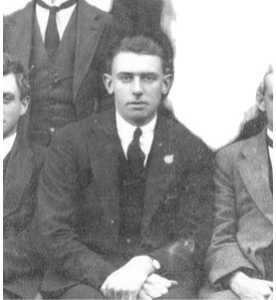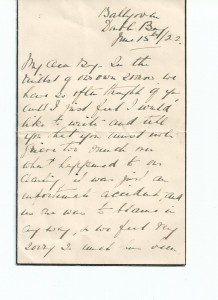Special Edition - Robert and Jack Shute Memorial Cup
- Eastwood Rugby Admin
- May 30, 2023
- 7 min read
Updated: Jun 14, 2024
Reproduced from the Wood eNews June 1 2022 The Shute Shield is named after Robert Shute who died playing football in 1922. On Saturday, 1st grade will play for the Robert and Jack Shute Memorial Cup. The winner will be presented with the Cup by Robert Shute's niece, Margie Oldfield (read her story below).
Also in attendance will be members of both Robert and Jack Shute families.
Left Robert Shute middleJack Shute, right the Robert and Jack Shute Cup
By Paul Treanor You usually have to be a Wallaby to get something named after you - like a stadium or grandstand. So it is incredible that the premier Sydney rugby competition still bears the name Shute Shield 100 years after Robert's death from a tackle made by Jack on Manly Oval on 5 June 1922. For Robert Shute wasn’t a Wallaby but an up and coming grade player who’s death left an everlasting memory on the rugby community. Back in 2013 when I first wrote the story about the origins of the Shute Shield it struck me the utter madness of the situation of a young man surviving the war in Europe and the Spanish Flu to come back home and be killed just playing a game of football. I could not imagine how his family must have reacted to the news. Robert Shute’s oldest surviving relative Margie Oldfield wasn’t born until 1933 and said the family did not talk about it however he was remembered.
Jack Shute's grandson, Nathan will be doing his 300th NSW game as a referee when he takes charge of the Colts 1 match at University Oval No 2. He will also be assistant referee for first grade. "Grandpa John retold the story many times even in his last days on Earth. He and the Shute Shield legacy have inspired me to make a difference with the game now and for many years to come."
One thing that has improved in the last 100 years of rugby is the treatment of head injuries . The changes to the rules on contact to the head may annoy many with the increase in Red cards, but the long term damage caused and in Robert's case death outweighs any annoyance.
Robert Shute Obituary from Sydney University Hermes Magazine

Margie Oldfield's Connections with Eastwood and Rugby
By Paul Treanor

Searching the internet for information on the uncle she never knew, Margie Oldfield stumbled on the article on the Shute Shield written back in 2013. She discovered more about her uncle Robert Shute and so she sent a letter to Eastwood Rugby. Timing is everything they say and so her contact with us coincided with the 100 year anniversary of her uncle’s death. Margie will be attending the game on Saturday and will present the Cup to the winners. Margie and her husband John have just retired from the family farm at Belalie - 100 km north of Bourke! In getting to know Margie we discovered she has connections with Eastwood and rugby. In fact she and her two sisters, Elizabeth and Ann, were born in Eastwood when her father John Lloyd opened and managed a branch of the Commercial Banking Co. of Sydney at Eastwood. The family moved to Goulburn when Margie was one and then to Parramatta where Margie met her future husband John Oldfield who played first XV with Kings. John was part of their 1951 undefeated GPS side. The King’s connection continued with her youngest son Peter, a hooker, playing first XV before playing with Wollongong University. He hung up his boots when he’d had enough concussions. (Maybe a message from his great uncle helped him make that decision!). “My eldest son, Tim, played with a team called Colleagues after school. A game when they played Hunters Hill was the last football game I watched! Tim has just turned 60!” So after such a long break from watching rugby Margie will be at University Oval tomorrow to watch her first game this century as the current crop of club rugby players take the field and do battle.
Update 2023: Here's Margie presenting the inaugural Robert and Jack Shute Cup in 2022 to the winners, University
Robert Shute's Family Remembers
Left Robert Shute's mother Amy; on the right Margie's father John Lloyd standing outside the Commercial Banking Company Eastwood branch.
While the rugby community remembers Robert Shute through the Shute Shield, Robert’s family remembered him in their own quiet way as explained by Margie. "His memory was obviously treasured. My grandmother lived with us for six months each year and the other six with my aunt, Enid Leah, at Newcastle. Nan used Uncle Bob’s bedroom furniture and one of my sons uses his lowboy now. Mum gave me his stamp album. I have his Sydney Grammar School badge and a rowing trophy. I have a large photo of him at about 2 years old and his army photo. I have his shoulder patches from his army uniform, his discharge form and a postcard from London about his return to Australia. There is some trench art made from a German shell and my son, Richard, reminded me that he has his wrist watch from W.M.Farmer and Co dated 1917. John has his camera. So you can see that his memory was precious. I must say, reading the copy of Nan’s letter to Jack Shute brought tears to my eyes. It was such a kind thing to do and I only learnt about it through you. Nan lived till she was 97, cared for by my mother and her sister.”
June 15th /22 “My Dear Boy – In the midst of our own sorrow we have so often thought of you, and I just feel I would like to write and tell you that you must not grieve too much over what happened to our darling, it was just an unfortunate accident, and no one was to blame in anyway, & we feel very sorry so much has been said about it for your sake, as everyone says what a good clean player you are, and like our own Bob a true sport. Thanking you very much for your kind sympathy. Believe me Yours Sincerely Amy Shute.”
City Girl Moves to the Country
Here is Margie's story on the transition from city life to that of a famer. John and I met when we were 17 and married when we were 24 at St Saviours Cathedral in Goulburn.
My parents weren’t bothered by the thought of my going to Bourke because Dad’s sister lived near Coolabah and they knew life was quite civilised out there. I’d stayed with John’s family and the social life was great although things went quiet in the summer. At first we lived in a small cottage on John’s fathers property, “Gurrawarra”, on the Culgoa River. There were certainly things to get used to. I told John I could live anywhere provided I had hot water and could pull the chain! I had to wait a few months for the indoor toilet but we had water heated by the fuel stove. I was not domesticated and preferred time in the garden with Dad, but Mum armed me with the Commonsense Cookery Book.
My father in law kindly boiled water in the copper so I didn’t have to wash my sheets in the muddy Culgoa water. However I soon got over being so precious. I also learnt to sieve the weevils out of the flour instead of taking it back to the store for replacement. I once sat outside for most of the day waiting for John to come home because there was one of those wasps with the dangly legs inside the house! Before we had the indoor toilet I once met a mob of wild pigs between the house and the long drop. John had to come with me every time after that!
After 5 years and three babies we knew we had to get a place of our own and when we had organised finance Belalie came on the market. It had once been a very large property but blocks had been taken off it for soldier settlement and it now measured about 20,000 acres. We were fortunate to have the old homestead which was heaven after the one bedroom cottage. There had been jackeroos, a cowboy gardener and cook housekeeper, plus a manager and his wife and the odd governess. By the time the area of Belalie was so reduced it was impossible to support staff. It’s great claim to fame was that Will Ogilvie, the Scottish bush poet, had been a jackeroo there and it figures in quite a few of his poems. It was owned by the Scott family at that time and it was said that Will was smitten with one of the Scott daughters. One book of his poetry was call “Fair Girls and Grey Horses”. Belalie has been a sheep station and cattle property when the seasons were good enough. Mainly it has been running merino sheep – they are tough animals. Now the property is changing to running goats. Shearing has been very difficult lately as it is very expensive and it is hard to find a good shearing team. The low average rainfall means that it is not farming country.
It was impossible to make a living from our original 20,000 acres and adjoining properties have been acquired over the years to make a viable property.
Belalie was a wonderful place to bring up children. We ended up with two daughters and three sons and I taught Correspondence for 12 ½ years, before the days of School of the Air. The lessons came from Sydney. I didn’t mind the teaching and the children got an excellent grounding in the 3 R’s before they went off to boarding school. Boarding school broadened their horizons although they weren’t too keen on all those rules.
Links to our earlier articles on this fascinating story https://www.eastwoodrugby.com.au/post/jack-shute-first-club-president https://www.eastwoodrugby.com.au/post/shute-story
















Comments